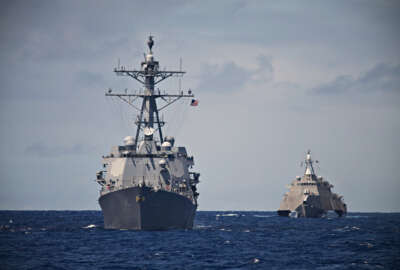Insight by Leidos
DoD Cloud Exchange: Leidos’ Derrick Pledger on multi-domain operations at scale
A modern U.S. military requires a resilient, data-driven ecosystem that can flex at scale. We learn about the microservices, containerization and secure APIs ne...
Nearly 20 years later, net-centricity has given away to data centricity as technology and the importance of data has evolved.
DoD is on a fast track to achieve data centricity across all systems and domains to create the baseline for advanced multi-domain operations (MDO), said Derrick Pledger, vice president and director of digital modernization at Leidos.
“That concept is really about addressing incompatibilities of data formats, networks, message formats as well as platforms. But most importantly, how do you ensure that data can traverse the network securely?” Pledger said during Federal News Network’s second annual DoD Cloud Exchange.
Answering that question forces development teams to build resilience and trust into all of Defense systems, Pledger said. “You need the strategic pieces, and you also need the tactical. It boils down to addressing the lack of interoperability of warfighting systems, which is really about breaking stovepipes across data operations and mission applications. It’s about developing solutions to address bandwidth limitations and tactical communications requirements.”
Underpinning all of those efforts is, of course, cloud services. And it’s clear the Pentagon will remain in a hybrid and multi-cloud environment for the foreseeable future.
Cloud viewed as vehicle to give DoD decision advantage
It’s why multi-domain operations require a fundamental shift in how DoD, or really any agency for that matter, ensures interoperability and modernizes network, application and system technology, Pledger said.
“MDO is really a warfighting concept that is characterized by exploiting the connection of data platforms and warfighters across domains to drive collaboration and decision advantage,” he said. “The complexity of today’s battlefield dynamics really forces us to ensure that we can compete and contest across all domains, whether that be air, sea, land, space or also cyber. We think the true challenge is moving from bespoke, closed architectures and monolithic systems to more agile, open architectures and nonproprietary frameworks that enable both rapid and iterative capability improvements.”
The challenges for the military services and Defense agencies is how to connect legacy systems and platforms to modern capabilities to enable that data flow and decision-making.
DoD needs to employ microservices architectures and other capabilities to keep legacy systems running as well as enhance those systems’ capabilities to work with modern cloud services, Pledger said.
“I can do that faster, in weeks or months as opposed to spending a billion dollars building or rebuilding a legacy system. We just don’t have time to do that,” he said. “I think the mission is really driving the requirement to be able to build solutions faster and securely, and such that we’re able to respond to emerging threats.”
MDO tied to three technology pillars
Moving to microservices, containerization and other approaches also makes it easier to collect and use data in the field — and the point when decisions need to made in seconds and not minutes or more. This is especially important when warfighters can’t connect back to the network.
Pledger said the goal is to move applications and capability to the tactical edge to maintain operational effectiveness.
“MDO hinges on three technology pillars. The first is digital infrastructure and cyber resilience. The second is mission software and data management. And then the third is platform integration and interoperability,” he said. “How can you build what I would call ‘glueware’ between our legacy systems and new capabilities that are out there to make sure fundamentally data can traverse and has access to the warfighter and applications that are out there? Building in microservices between those systems is critical, so we’re able to address mission requirements now, as opposed to rebuilding systems.”
Of course, it’s of the utmost importance that cybersecurity is baked in during the development of these microservices, Pledger said. To do that requires building application programming interfaces (APIs) securely and not expanding attack surfaces, he added.
Another key MDO factor is finalizing data standards. If the microservices and APIs don’t understand the data calls, the entire effort becomes more complex and less successful.
Creating the military infrastructure of the future
Interoperability is one of the pillars of digital transformation.
“Mission software and applications are only as good as the information that they have access to,” Pledger said. “Being able to execute data management across cloud, on premise and in edge environments becomes increasingly important.”
Frankly, secure data management is probably the No. 1 priority since many of DoD’s platforms and systems need to be interoperable and drive mission outcomes, he said. “Those APIs are making sure that we can build microservices quickly so we are able to connect new systems to get critical insight across all of our data. That is really important for us to be able to have a decision advantage.”
All of these technologies and approaches if done properly can give DoD commanders an agile and resilient digital infrastructure that includes real-time situational awareness and decision dominance, Pledger said. That’s the goal ultimately.
“The force wants the same experiences on a battlefield that they have at the enterprise. They don’t want there to be a difference, and they want persona-based experiences such that they have the tools they need to be able to effectuate decisions,” Pledger said. “That all leads into operational effectiveness. I think having that digital infrastructure, having that ecosystem at scale, is the only way that we’re going to be in the best position to win the fight.”
To listen to and watch all the sessions from the 2022 Federal News Network DoD Cloud Exchange, go to the event page.
Copyright © 2024 Federal News Network. All rights reserved. This website is not intended for users located within the European Economic Area.
Related Stories
Featured speakers
-

Derrick Pledger
VP, Director of Digital Modernization, Leidos
-

Jason Miller
Executive Editor, Federal News Network
On DoD
Upcoming Events
Related Stories
Top Stories

Derrick Pledger
VP, Director of Digital Modernization, Leidos
Derrick Pledger, an 11-year veteran of Leidos, is responsible for leading the corporation’s Digital Modernization organization. Since joining Leidos, he has held multiple engineering and technical management positions of increasing scope and responsibility, including Enterprise Solution Architect, Chief Engineer, Program Manager, Chief Infrastructure Architect, and Lead Systems Integrator. He has also spent over two years deployed to Iraq, Afghanistan, and Africa in support of Operation Iraqi & Enduring Freedom missions and counter-piracy operations. His expertise ranges from managing complex software programs and designing hybrid cloud environments to supporting development, systems integration, and data exploitation efforts for a number of Department of Defense (DOD) customers.

Jason Miller
Executive Editor, Federal News Network
Jason Miller has been executive editor of Federal News Network since 2008. Jason directs the news coverage on all federal issues. He has also produced several news series – among them on whistleblower retaliation at the SBA, the overall impact of President Obama’s first term, cross-agency priority goals, shared services and procurement reform.







